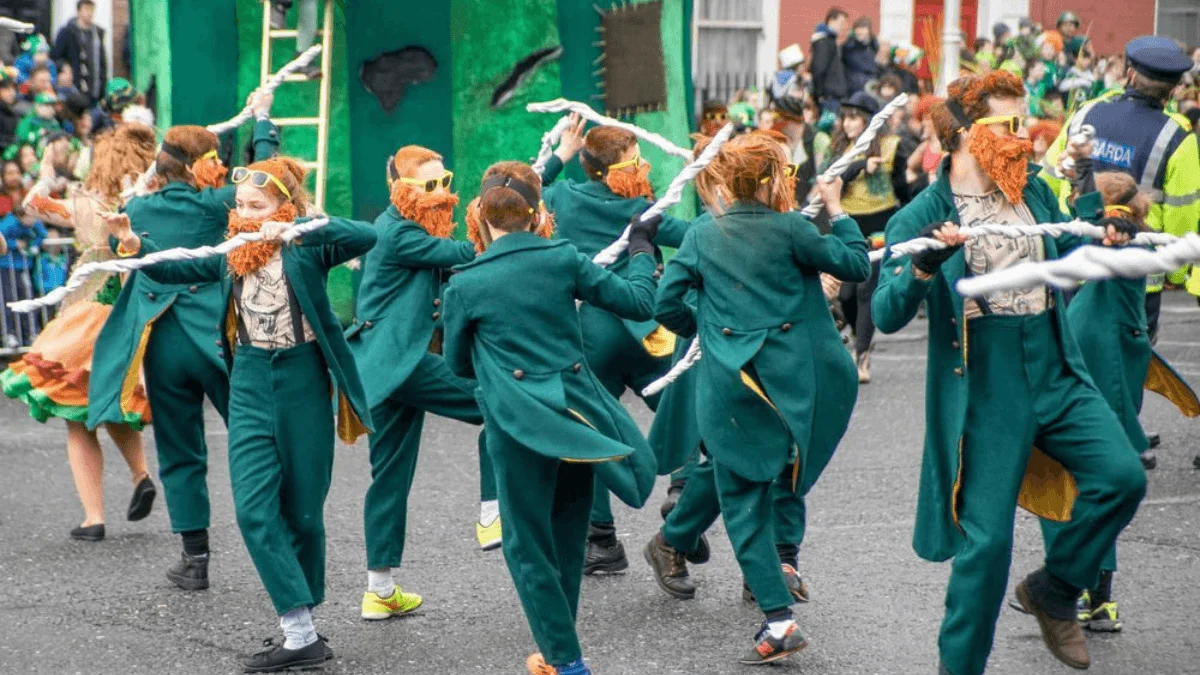St. Patrick’s Day, celebrated every year on March 17th, is a cultural and religious holiday originating from Ireland. It commemorates St. Patrick, the patron saint of Ireland, and the arrival of Christianity in Ireland.
Over time, the holiday has evolved into a global celebration of Irish culture, filled with festivals, parades, and, of course, a sea of green. This blog post aims to delve into the tradition of St. Patrick’s Day, offering readers a deeper understanding of this vibrant holiday.
Tradition St. Patrick’s Day Customs Parades
1. Origin of Parades
St. Patrick’s Day parades have a rich history dating back to the 18th century. The first recorded parade took place in New York City in 1762, organized by Irish immigrants serving in the English military.
They marched through the city streets, playing Irish music and celebrating their heritage.
2. Evolution of St. Patrick’s Day Parades
Over the years, these parades have evolved into grand affairs, featuring marching bands playing traditional Irish music, bagpipers in kilts, and dancers performing intricate Irish dances.
Participants and spectators alike are decked out in green, the color most associated with Ireland.
3. Global Spread of Parades
Today, St. Patrick’s Day parades are held in cities across the globe, from Dublin to Sydney to Tokyo, each adding their unique cultural twist to the celebrations.
4. Significance of Parades in Modern Celebrations
In many places, the parade is just the beginning of the day’s festivities, which may also include concerts, cultural events, and communal meals.
These parades serve as a testament to the global influence of Irish culture.

Wearing Green on St Patrick’s Day
1. Historical Significance of Green
The tradition of wearing green on St. Patrick’s Day started in the 17th century when people wore green ribbons and shamrocks on March 17th to honor Ireland’s patron saint.
The color green has long been associated with Ireland, earning it the nickname “The Emerald Isle.”
2. Symbolism of Green in Irish Culture
Green is a color deeply embedded in Irish history and culture. It represents the lush landscapes of the country and is a symbol of rebirth and renewal.
3. Modern Interpretations of the Tradition
Over time, the tradition has evolved, and today people around the world dress in green clothing and even dye their hair green in honor of the holiday.
This act of wearing green has become a universal sign of solidarity and respect for Irish culture.
4. Global Adoption of Wearing Green
The tradition of wearing green has been embraced by people of all cultures around the world, making St. Patrick’s Day a truly global celebration
Shamrock
1. Shamrock and St. Patrick
The shamrock, a three-leafed clover, is a symbol closely associated with St. Patrick’s Day. According to legend, St. Patrick used the shamrock as a metaphor for the Holy Trinity when he was first introducing Christianity to Ireland.
The three leaves of the shamrock represent the Father, the Son, and the Holy Spirit in Christian belief.
2. Symbolism of the Shamrock in Irish Culture
In Irish culture, the shamrock holds a significant place. It is seen as a symbol of faith, hope, and love. Moreover, it is believed to bring good luck, making it a common sight during St. Patrick’s Day celebrations.
3. Shamrock in Modern Celebrations
Today, the shamrock is a ubiquitous symbol of St. Patrick’s Day. It can be seen everywhere on the holiday, from parade floats and decorations to the green clothing people wear. Some people even go so far as to get shamrock tattoos in honor of their Irish heritage.
4. Global Recognition of the Shamrock Symbol
The shamrock has gained global recognition as a symbol of Irish heritage and St. Patrick’s Day. Its simple yet powerful symbolism resonates with people around the world, making it a universally recognized symbol of the holiday.
Traditional Irish Foods
1. Role of Food in Irish Celebrations
Food plays a central role in any celebration, and St. Patrick’s Day is no exception. Traditional Irish foods are a key component of the holiday, providing a delicious way to honor Irish culture and history.
Traditional Irish dishes such as Irish stew, colcannon (a dish of mashed potatoes and kale or cabbage), and soda bread are often enjoyed on St. Patrick’s Day. These hearty dishes reflect the simplicity and warmth of Irish cuisine.
2. Popular Dishes on St. Patrick’s Day
In addition to traditional Irish foods, some dishes have become particularly associated with St. Patrick’s Day. Corned beef and cabbage is a common meal enjoyed on this day, especially in the United States. In Ireland, people are more likely to eat lamb or bacon.
3. Influence of Irish Cuisine on Global Food Culture
Irish cuisine, with its emphasis on simple, hearty ingredients, has influenced food cultures around the world.
On St. Patrick’s Day, people of all backgrounds come together to enjoy these traditional dishes, showcasing the global appeal of Irish food.
Irish Music and Dance on St Patrick’s Day
1. Importance of Music in Irish Culture
Music is an integral part of Irish culture, serving as a means of storytelling, celebration, and preservation of history.
Traditional Irish music, with its distinctive instruments like the fiddle, the bodhrán (a type of drum), and the uilleann pipes, is played at parades and celebrations, adding to the festive atmosphere.
2. Traditional Irish Music Genres
Irish music is diverse, with genres ranging from folk and traditional to rock and pop. However, on St. Patrick’s Day, it’s the traditional Irish music that takes center stage.
This music is characterized by its unique rhythm and melody, which often tell a story or convey a particular emotion.
3. Irish Dance: A Symbol of National Identity
Irish dance is another important aspect of St. Patrick’s Day celebrations. Characterized by its rapid foot movements and high kicks, Irish dance is a dynamic and exciting art form. It serves as a symbol of national identity and a celebration of Irish culture.
4. Global Influence of Irish Music and Dance
Irish music and dance have had a significant influence on global culture. From the popularity of shows like Riverdance to the worldwide success of bands like U2 and The Cranberries, Irish music and dance have made their mark on the world stage.
Modern Traditional Changes in St. Patrick’s Day Celebrations
1. Globalization of St. Patrick’s Day
St. Patrick’s Day, once a religious holiday celebrated primarily in Ireland, has transformed into a global phenomenon.
Cities around the world, from Chicago to Sydney, now host parades and other festivities, demonstrating the widespread influence of Irish culture.
2. Evolution of Parades
While parades have been a part of St. Patrick’s Day celebrations for centuries, they have evolved significantly over time. Modern parades often feature elaborate floats, performances by marching bands, and participants dressed in extravagant costumes. Some cities even dye their rivers green for the occasion.
3. Modern Interpretations of Wearing Green
The tradition of wearing green has taken on new forms in recent years.
In addition to clothing, people now dye their hair green, paint their faces, and even dress their pets in green. This playful interpretation of the tradition adds a sense of fun and whimsy to the celebrations.
Food and Drink on St Patrick’s Day
While traditional Irish foods continue to be a staple of St. Patrick’s Day celebrations, modern festivities often include a wider variety of food and drink.
Many pubs and restaurants offer special menus for the day, featuring Irish-inspired dishes and drinks.
The popularity of green beer is one example of a modern addition to the holiday’s food and drink traditions.
Environmental Considerations
In recent years, there has been a growing emphasis on making St. Patrick’s Day celebrations more environmentally friendly.
Many parade organizers now encourage participants to consider the environmental impact of their floats and costumes.
Additionally, some cities have started using environmentally friendly dyes for their rivers.
Related Post
Conclusion
St. Patrick’s Day is a vibrant and dynamic holiday that has evolved from a religious observance in Ireland into a global celebration of Irish culture.
Its traditions, from parades and wearing green to enjoying traditional Irish foods and music, offer a rich tapestry of experiences that connect people around the world to Irish heritage.
The holiday continues to evolve, with modern interpretations of traditions and the incorporation of technology and environmental considerations. Despite these changes, the core spirit of St. Patrick’s Day remains the same – a celebration of Irish culture, history, and community.

